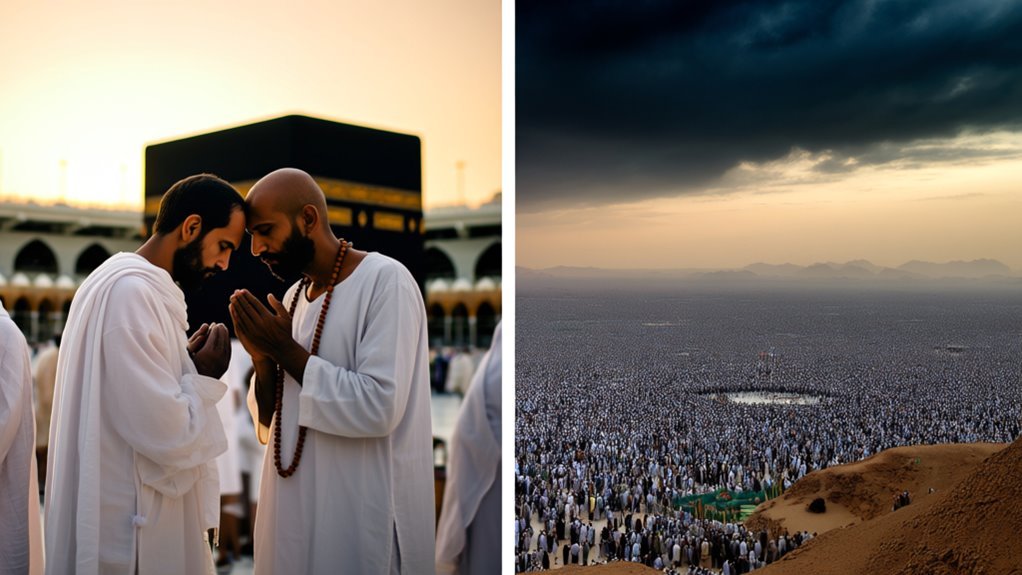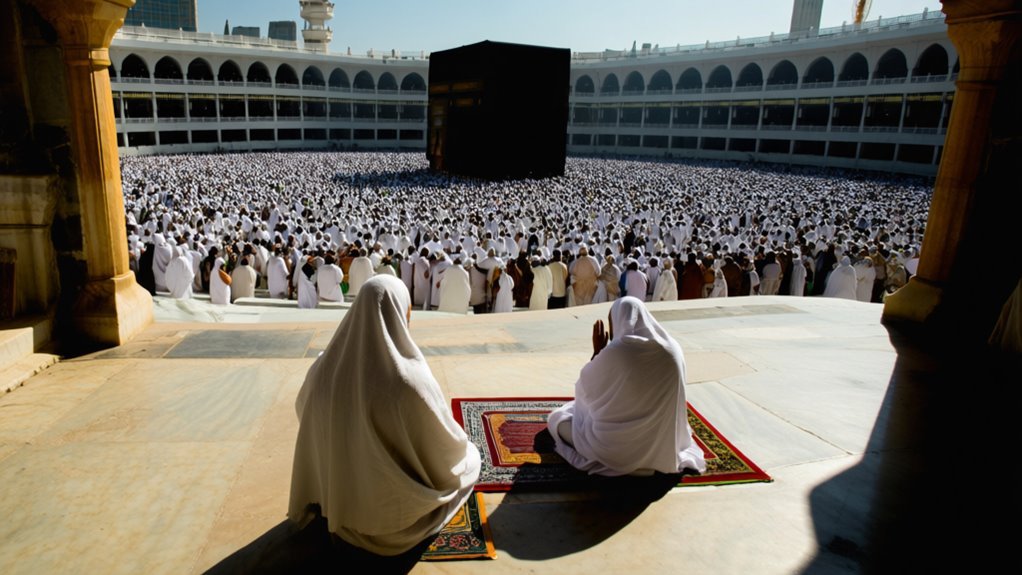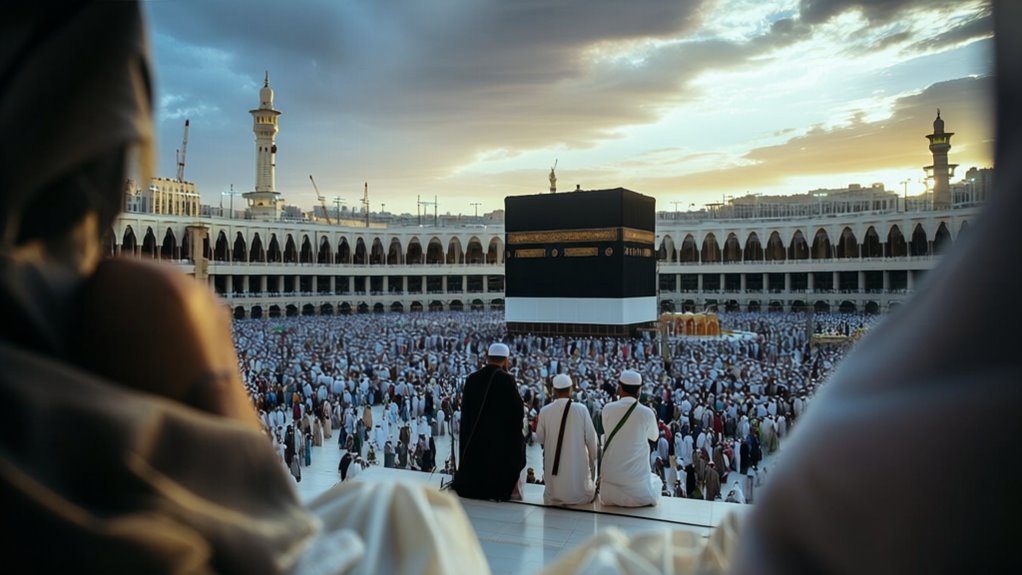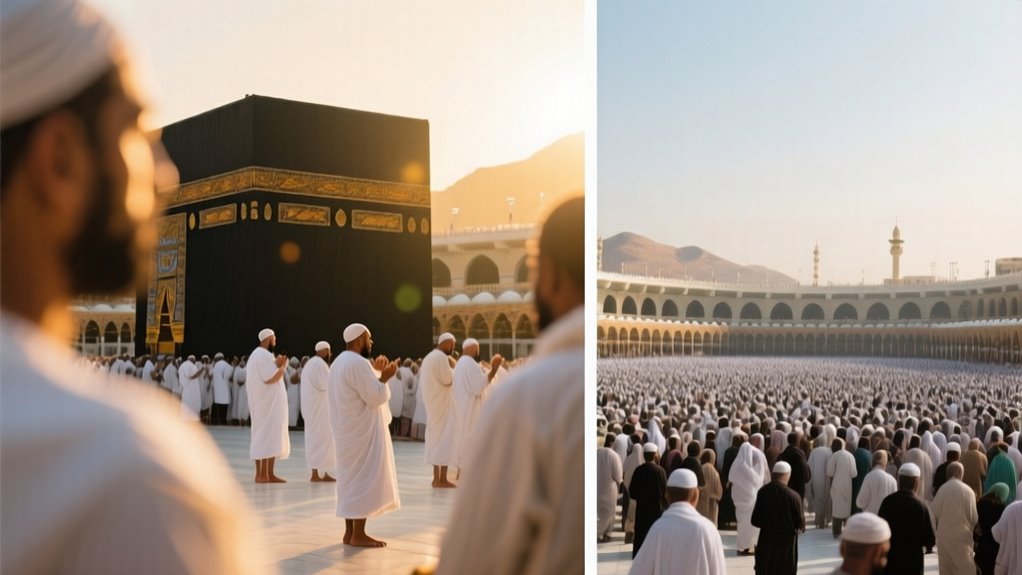You’ll find that Umrah is a voluntary, shorter pilgrimage you can perform anytime, focusing on rituals like Ihram, Tawaf, and Sa’i.
Hajj is an obligatory, multi-day event with more complex rites such as Wuquf at Arafat and stoning the Jamarat during Dhu al-Hijjah.
Both require similar basic rituals and spiritual preparation, but Hajj demands stricter timing, higher costs, and specific visas.
Understanding these distinctions reveals their unique roles in spiritual growth and community unity.
Key Takeaways
- Umrah is a voluntary minor pilgrimage with fewer rituals, while Hajj is a mandatory major pilgrimage with extensive rites required once in a lifetime.
- Hajj occurs annually during specific days in Dhu al-Hijjah, whereas Umrah can be performed any time of the year.
- Both pilgrimages share rituals like Ihram, Tawaf, Sa’i, and hair-cutting, but Hajj includes unique rites such as Wuquf at Arafat and stoning the Jamrah.
- Hajj demands special visas, higher costs, and strict scheduling, while Umrah offers more flexible visa availability and lower expenses.
- Both pilgrimages offer deep spiritual benefits, with Hajj emphasizing obedience and unity, and Umrah focusing on voluntary purification and reflection.
Definition and Religious Obligation

What distinguishes Umrah from Hajj lies primarily in their definitions and religious obligations. Umrah is a voluntary “minor pilgrimage” to Mecca that you can perform anytime, involving fewer rituals like Ihram, circumambulation, Sa’y, and shaving the head. It represents a voluntary act of worship with spiritual significance. It’s highly meritorious but not obligatory, and you may perform it multiple times. Unlike the fixed timing of Hajj, Umrah offers flexibility similar to how some tours explore diverse cultural sites throughout the year, as seen in Egypt and Jordan cultural landmarks.
In contrast, Hajj is a mandatory pilgrimage required once in your lifetime if you meet physical and financial criteria. It occurs annually in Dhu al-Hijjah, with more extensive rites such as standing at Arafat, stoning at Mina, and animal sacrifice. Hajj represents one of the Five Pillars of Islam, emphasizing its foundational religious importance.
Both pilgrimages trace back to the Prophet Muhammad but differ profoundly in their obligatory nature and ritual complexity.
Timing and Duration of the Pilgrimage
You’ll notice Hajj has a strictly fixed timing tied to specific days in Dhul-Hijjah, lasting about five to six days with a set sequence of rituals. This period includes crucial rites such as standing at Arafat and the symbolic stoning of the devil at Mina, which are unique to Hajj. In contrast, Umrah offers flexible timing and can be completed in a few hours to a full day, depending on crowds and personal pace. These differences fundamentally shape how you plan and experience each pilgrimage. Unlike Umrah, Hajj must be performed once in a lifetime if conditions such as adult, healthy, and financially capable are met. Planning for these pilgrimages often involves considering organized travel arrangements to ensure a smooth experience.
Fixed Vs Flexible Timing
Because Hajj occurs during a narrowly defined period from the 8th to the 12th or 13th of Dhul-Hijjah, its timing demands strict coordination and adherence to specific calendar dates and ritual sequences. You must plan your Hajj pilgrimage precisely, aligning with fixed rituals like Wuquf at Arafat and the stoning of Jamaraat, all regulated by authorities within this set timeframe. These rituals collectively last for five to six days, encompassing various rites that mark the spiritual culmination of the pilgrimage.
In contrast, Umrah offers you flexibility, as it can be performed anytime except the main Hajj days and certain restricted dates. This flexibility allows you to schedule your trip based on convenience or crowd conditions.
Hajj’s fixed timing involves coordinated logistics and higher costs due to large pilgrim influxes.
While Umrah’s adaptable timing supports individualized planning with less stress on travel and accommodation arrangements, it typically takes only hours to a day to complete, making it a shorter and more accessible pilgrimage option.
Duration Comparison
A clear understanding of the duration differences between Umrah and Hajj helps you plan your pilgrimage efficiently.
Umrah’s core rituals—Ihram, Tawaf, Sa’i, and Halq/Taqsir—typically take 3 to 6 hours, with flexibility based on crowd size and personal pace. You can complete Umrah swiftly or extend it over a day for reflection. Moreover, Umrah is performed any time, allowing pilgrims to choose the most convenient moment for their spiritual journey.
Packages usually cover 5 to 10 days, including travel and additional worship.
In contrast, Hajj requires a fixed commitment of 5 to 6 days for core rites from the 8th to 12th of Dhul-Hijjah. Its strict schedule involves overnight stays at Mina, Arafat, and Muzdalifah, with logistical complexity demanding 10 to 14 days overall.
Understanding these timing distinctions enables you to prepare appropriately for either pilgrimage’s unique duration and requirements.
Essential Rituals and Practices

While Umrah and Hajj differ in scope and timing, they share several essential rituals that define the pilgrim’s spiritual journey. You begin by entering Ihram at designated Miqat points, donning simple garments and reciting the Talbiyah prayer.
Umrah and Hajj start with Ihram at Miqat points, wearing simple attire and reciting the Talbiyah prayer.
Both pilgrimages require you to perform Tawaf—circling the Kaaba seven times—and Sa’i, walking seven times between Safa and Marwah. The Ka’bah, regarded as the House of God, is the central focus during Tawaf.
You conclude by shaving or cutting your hair, symbolizing renewal. Many pilgrims also take the opportunity to experience significant cultural and traditional performances during their journey, similar to the way visitors engage in Bali’s rich culture through traditional dance.
Throughout, maintaining ritual purity remains vital. Drinking Zamzam water is also recommended during both.
Though these acts are mandatory, you may engage in additional non-obligatory practices, such as visiting Medina.
This shared structure highlights the core devotional framework common to both pilgrimages, despite Umrah’s flexibility and Hajj’s fixed schedule and expanded rites.
Unique Rituals Exclusive to Hajj
When you perform Hajj, you experience Wuquf at Arafah, a vital ritual where pilgrims stand in prayer and reflection on the 9th of Dhul-Hijjah. This marks the spiritual peak of the pilgrimage.
Another exclusive practice is the Stoning of the Jamrah, symbolizing the rejection of evil through throwing pebbles at stone pillars over several days. These rituals emphasize themes of mercy, forgiveness, and spiritual purification unique to Hajj.
Many travelers seek spiritual journeys similar to Hajj by exploring cultural and historical tours, such as the Best of Turkey Egypt Tour Package which offers a deep cultural immersion.
Wuquf at Arafat
How critical is Wuquf at Arafat to the Hajj pilgrimage? It’s the essential, mandatory pillar without which your Hajj is invalid.
From just after Zuhr until sunset on the 9th of Dhul-Hijjah, you’ll stand or sit if necessary on the plain of Arafat, near Jabal al-Rahmah, reflecting the Day of Judgment. This standing must be done between midday and Fajr the next day for valid Hajj, emphasizing the timing requirement of the ritual.
This period, unique to Hajj and absent in Umrah, emphasizes spiritual cleansing and accountability.
During Wuquf, you engage in continuous du’a, dhikr, and Quran recitation, avoiding distractions like excessive eating or idle talk.
Combining Dhuhr and Asr prayers in congregation is required.
This prolonged standing signifies submission, offering a profound opportunity for repentance and sincere renewal.
Wuquf is rightly deemed the “heart” of Hajj, underscoring its unparalleled spiritual and jurisprudential significance.
Stoning the Jamrah
Why does stoning the Jamrah hold such a special place in the Hajj pilgrimage?
This ritual, unique to Hajj, symbolizes rejecting evil and Satan, echoing Prophet Ibrahim’s trial.
During the Days of Tashreeq (11th-13th Dhul-Hijjah), you throw seven pebbles at each of the three stone pillars, starting with the smallest. The stones represent a physical and spiritual act of rejecting Shaytan and evil.
On the 10th, you target only the largest Jamrah.
| Date | Jamrah Targeted | Number of Pebbles |
|---|---|---|
| 10th Dhul Hijjah | Al-Aqabah (largest) | 7 |
| 11th-13th Dhul Hijjah | Al-Sughra, Al-Wusta, Al-Aqabah | 21 (7 each) |
This act requires patience, discipline, and focus even in crowded conditions.
It marks a spiritual cleansing before Hajj concludes.
Spiritual Significance and Purpose

Although both Umrah and Hajj serve as profound spiritual journeys, they fulfill distinct roles in a Muslim’s religious life, each with unique significance and purpose.
Umrah, a voluntary act performed year-round, offers spiritual purification and personal reflection. It helps you cleanse minor sins and deepen your connection with Allah. Its flexible timing and less demanding rituals provide accessible opportunities for renewal. Unlike Hajj, Umrah does not include the standing at Arafat or stoning of the Jamarat, making it a shorter and simpler pilgrimage. Many pilgrims use this opportunity to visit nearby cultural sites to enhance their spiritual experience.
In contrast, Hajj, an obligatory pillar of Islam, represents the pinnacle of devotion. By retracing prophetic traditions and engaging in prescribed rituals during Dhul Hijjah, you seek forgiveness of major sins and experience unity among Muslims worldwide. Hajj encompasses extensive rituals such as Ihram, Tawaf al-Ifadah, Wuquf at Arafat, and animal sacrifice, emphasizing obedience and submission.
Hajj’s culmination at Mount Arafat underscores its role in spiritual renewal and ethical commitment.
Together, both pilgrimages foster spiritual growth but differ in scale, obligation, and depth of ritual significance.
Preparation Requirements and Permits
The spiritual significance of Umrah and Hajj lays the foundation for their practical preparations.
You must secure appropriate visas—Hajj requires a special Hajj visa valid only during Dhu al-Hijjah, while Umrah visas are available year-round, often electronically. Many travelers also consider combining their pilgrimage with cultural experiences in cities like Istanbul or London to enrich their journey with historical sightseeing activities.
Booking through approved agents is mandatory for Hajj, but Umrah arrangements offer more flexibility.
Health certifications and vaccinations are essential for both pilgrimages. Importantly, Hajj is mandatory only for Muslims who are financially and physically capable, underscoring the requirement of financial feasibility.
Key preparation requirements include obtaining valid passports, pilgrimage-specific visas, and health certificates according to Saudi regulations.
Completing mandated vaccinations, especially for Hajj, such as COVID-19 and meningitis, is vital.
Enter Ihram at designated Miqat points and prepare for ritual steps physically and mentally.
Understanding and fulfilling these permits and health conditions ensure compliance and readiness for your pilgrimage.
Rules for Women Pilgrims
When you commence the pilgrimage, understanding the specific rules for women pilgrims is essential to guarantee proper adherence to religious obligations and local regulations.
Women must enter Ihram from designated miqat points and avoid shaving, trimming nails, using perfumes, or wearing makeup. Unlike men, you can wear stitched clothing but should expose only hands and face. Women must travel with a mahram, ensuring safety and fulfilling the conditions that make Hajj obligatory. It is also recommended to plan your journey considering cultural visits to enrich your spiritual experience.
During Tawaf and Sa’i, maintain a normal walking pace without jogging or running. Menstruating women can’t perform Tawaf. You must recite Talbiyah softly and avoid physical contact with your husband.
Traveling solo is allowed if you’re at least 18, but organized groups are recommended for safety. Managing menstruation, maintaining modesty, and following health guidelines are vital.
Finally, avoid prohibited behaviors such as backbiting and unnecessary exposure. Proper adherence ensures a respectful and spiritual experience.
Cost and Accessibility Considerations
Because demand surges dramatically during Hajj season and strict quotas limit pilgrim numbers, you’ll generally face higher costs and lower availability compared to Umrah. Hajj packages can cost anywhere from $6,000 to over $19,000 depending on your country and services, while Umrah packages start much lower, around $649. Many travel providers also offer specialized pilgrimage packages designed to accommodate these differences efficiently.
Accessibility is also constrained during Hajj due to tight quotas and prioritization, unlike Umrah which you can perform year-round without fixed limits. The Saudi government has facilitated pilgrimages by implementing visa reforms to streamline access, particularly for Umrah visitors. It is similar to how organized tours provide seamless experiences through well-planned itineraries and accommodations.
Consider these points:
- Hajj’s quota system restricts pilgrims and often causes long waitlists.
- Umrah visas are easier and faster to obtain than Hajj visas.
- Seasonal spikes during Hajj inflate prices for flights and accommodations sharply.
This cost and accessibility gap makes planning essential depending on your timeline and budget.
Benefits of Performing Umrah Before Hajj
Understanding the differences in cost and accessibility between Umrah and Hajj helps highlight distinct motivations for performing Umrah beforehand.
By performing Umrah first, you achieve spiritual cleansing as it expiates sins and purifies your soul, preparing you for Hajj. Exploring sacred journeys often reveals how destinations like Tokyo blend tradition and modernity, illustrating the harmony of spiritual and worldly experiences.
The Prophet Muhammad (ﷺ) emphasized this purification aspect, urging believers to seek forgiveness through Umrah.
Additionally, Umrah sharpens your faith and devotion, fostering a deeper connection with Allah and reinforcing humility essential for Hajj.
It also increases your spiritual rewards and mercy, elevating the acceptance of your subsequent Hajj rituals.
The benefits of performing Umrah during Ramadan are exponentially increased, making the purification and rewards even more profound.
Psychologically, completing Umrah eases stress by familiarizing you with sacred rites, promoting patience and focus.
Socially, it strengthens your bond with the Muslim community, enriching the collective pilgrimage experience during Hajj.
Frequently Asked Questions
Can Non-Muslims Perform Umrah or Hajj?
You can’t perform Umrah or Hajj if you’re not Muslim. Saudi Arabia strictly enforces this through visa screening and checkpoints to protect the sanctity of Mecca and Medina.
Only practicing Muslims receive permits, whether on tourist, work, or other visas.
This religious restriction preserves the spiritual unity and exclusive worship in these holy cities.
It aligns with both Islamic law and Saudi legislation, regardless of your nationality or reason for travel.
Are Children Allowed to Participate in Hajj or Umrah?
Imagine trying to navigate a busy market with a toddler. It’s chaotic and risky. Similarly, children under 12 (or 15, depending on the source) aren’t allowed to participate in Hajj from 2025 onward due to safety concerns.
However, you can bring children to perform Umrah, which is less crowded and physically demanding. This makes it accessible year-round.
Authorities impose stricter rules for Hajj, prioritizing adult pilgrims’ safety and logistics.
What Languages Are Commonly Spoken Among Pilgrims During Hajj and Umrah?
You’ll find English as the predominant language spoken among pilgrims during both Hajj and Umrah, serving as the main communication tool across diverse linguistic backgrounds.
Besides Arabic, common languages include Urdu, French, Malay/Indonesian, Turkish, Persian, Bengali, Hausa, Amharic, and Russian.
Saudi authorities also provide multilingual services in over 50 languages, ensuring clear guidance.
This linguistic diversity helps you engage spiritually and navigate the pilgrimage effectively.
How Do Medical Facilities Differ for Hajj and Umrah Pilgrims?
You’ll find that medical facilities during Hajj are vastly more extensive than for Umrah. Hajj offers 127 temporary and permanent rescue centers, full hospital services including surgery and cardiac care, and well-staffed primary health centers at key sites.
For Umrah, medical setups focus on basic urgent and primary care with fewer temporary clinics due to smaller pilgrim numbers and less congestion.
Hajj’s infrastructure ensures thorough, round-the-clock care for larger crowds.
Can Pilgrims Combine Umrah and Hajj in One Trip?
You can seamlessly weave the sacred threads of Umrah and Hajj into one pilgrimage through Tamattu’. This method allows you to perform Umrah first, exit Ihram, then don Ihram again for Hajj.
It requires a sacrificial offering and careful observance of rituals and regulations.
Conclusion
Understanding both Umrah and Hajj helps you appreciate their unique spiritual roles. Did you know over 2 million pilgrims perform Hajj annually, compared to around 10 million who undertake Umrah throughout the year?
This contrast highlights Hajj’s specific timing and religious obligation, while Umrah offers more flexibility. By grasping their differences and similarities, you can better prepare for your journey, ensuring you fulfill the rituals meaningfully and comply with all requirements.


0 Comment